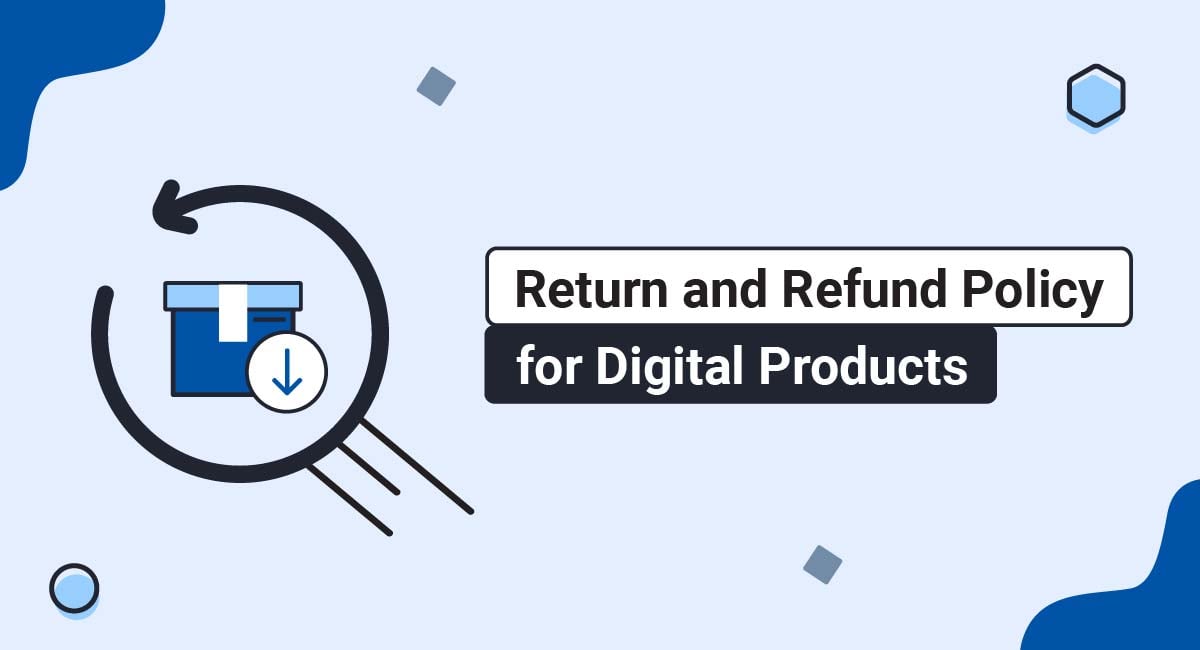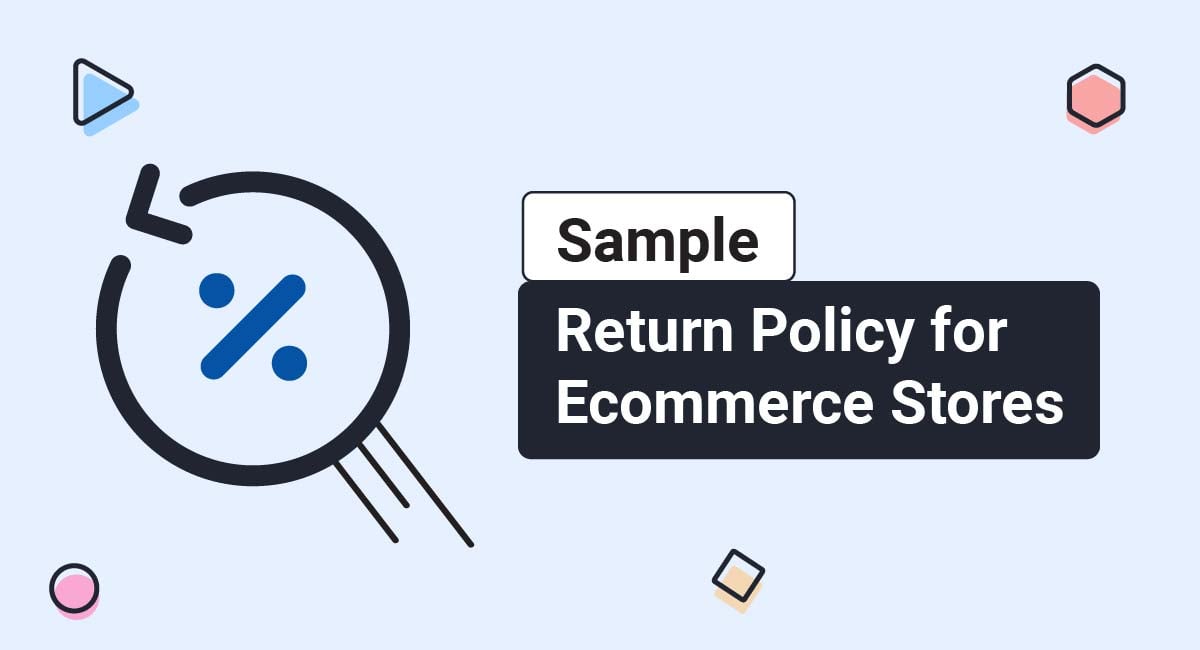According to a Deloitte Industries' online survey, U.S. consumers spend between $120 and $130 a month on digital goods and services, with signs that spending will continue to rise. As the amount of companies selling digital products increases, so does the importance of keeping customers informed and complying with consumer protection laws.
Maintaining a Return and Refund Policy for your digital products helps customers understand your policies and fosters legal compliance.
This article explains what a Return and Refund Policy is, whether you need one, and how to create and display a Return and Refund Policy for digital products.
Use our Return & Refund Policy Generator to generate a Return and Refund Policy for your store. Just follow these steps:
-
At Step 1, select where your Return & Refund Policy will be used.
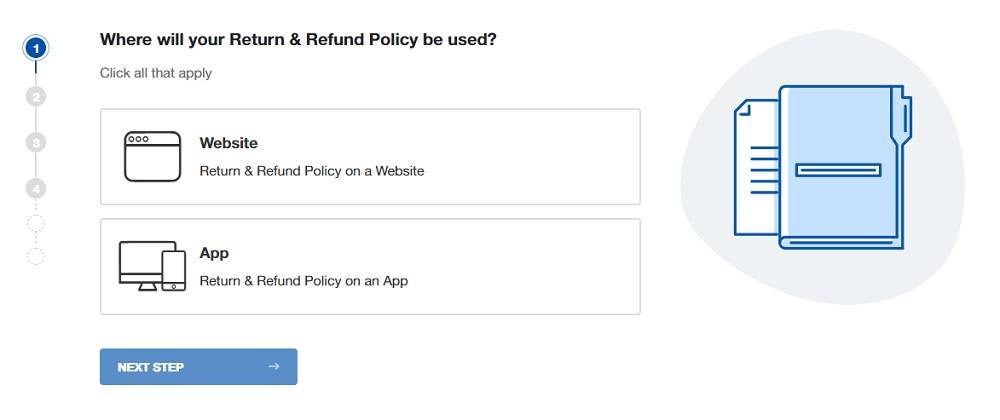
-
At Step 2, add information about your website/app and business.
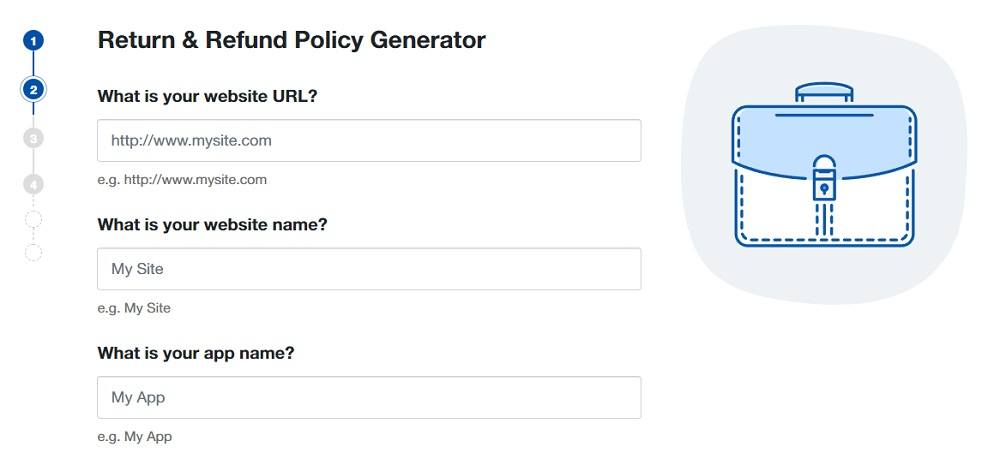
-
Answer some questions about your business practices.
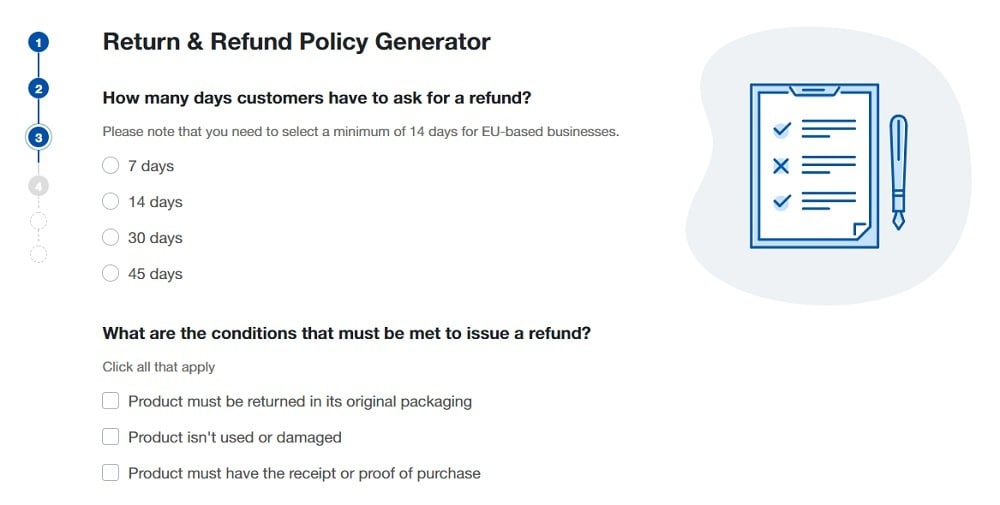
-
Enter an email address where you'd like to receive your Return and Refund Policy and click "Generate."
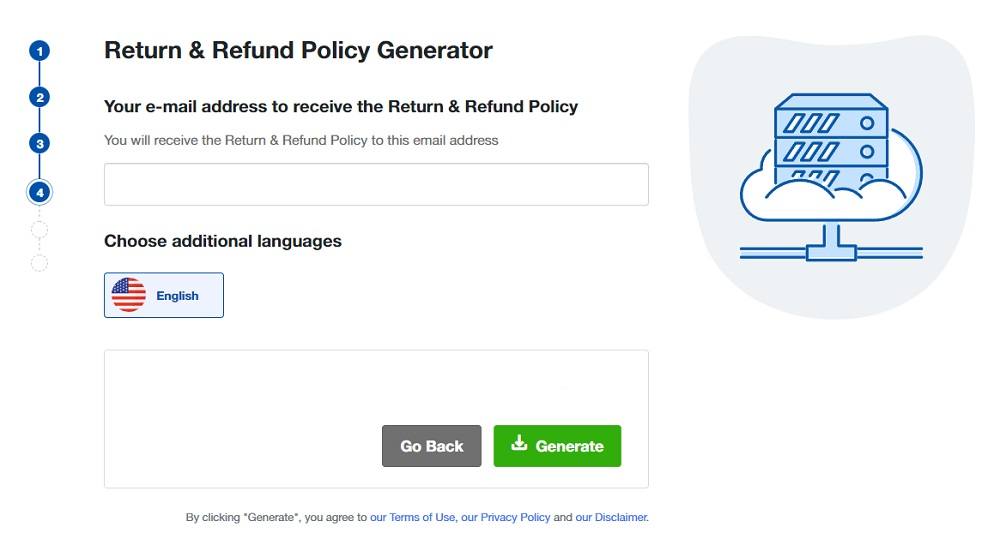
Done! You'll be able to instantly access and download your new Return and Refund Policy.
- 1. What is a Return and Refund Policy?
- 2. Do You Need a Return and Refund Policy for Digital Goods?
- 3. How Does Having a Return and Refund Policy for Digital Products Help Keep Customers Informed?
- 4. How Does Having a Return and Refund Policy for Digital Products Help You Comply With Applicable Laws?
- 5. What are Some Return and Refund Laws in the United States?
- 6. What are Some International Return and Refund Laws?
- 7. What Information Should Your Return and Refund Policy for Digital Products Include?
- 7.1. Whether You Issue Refunds for Digital Products
- 7.2. Requirements/Conditions for Returns
- 7.3. Refund Costs/Fees
- 7.4. How to Initiate/Request a Refund
- 7.5. Expected Refund Timeline
- 8. How Do You Display a Return and Refund Policy For Digital Products?
- 8.1. In a Website Footer
- 8.2. In a Terms and Conditions Agreement
- 8.3. On a Checkout Page
- 9. Summary
What is a Return and Refund Policy?
A Return and Refund Policy is a document that explains whether your business allows returns or refunds, details about what items are eligible for returns or refunds, and the steps customers need to take to return an item or request a refund.
Whether you allow returns or refunds or not, if you sell digital products (including apps, games, software, courses, and ebooks) you should have a Return and Refund Policy.
Apple's Returns and Refunds Policy includes information about how long customers have to return an item after they receive it and what items are eligible for return:
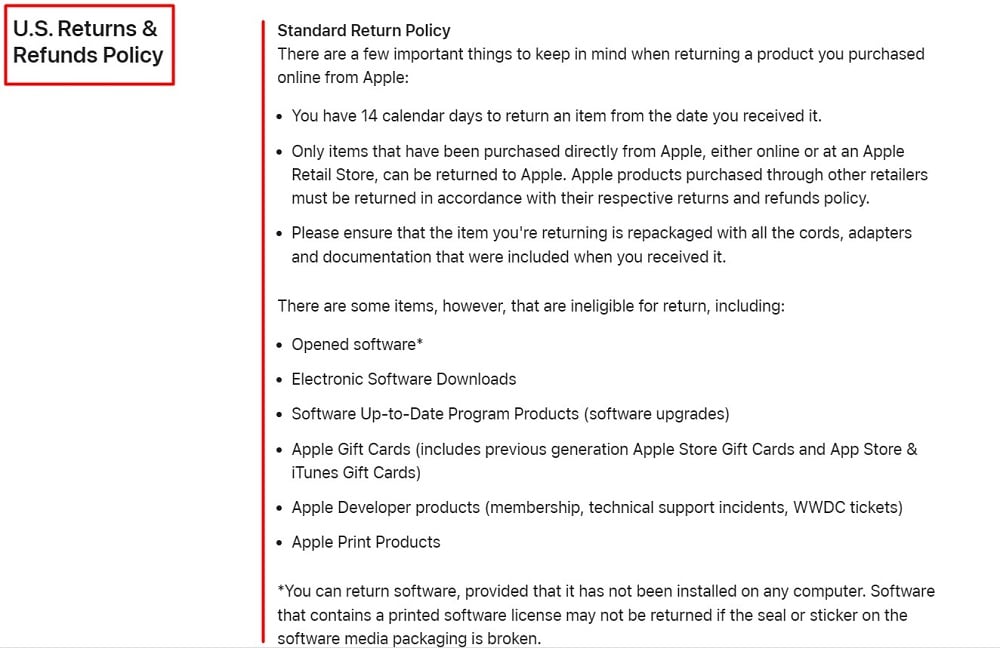
Do You Need a Return and Refund Policy for Digital Goods?
You will need a Return and Refund Policy for digital goods if you want to enforce any unique or restrictive limits on returns. However, regardless of whether it's required, any business that sells physical or digital products or services should have a Return and Refund Policy.
Your Return and Refund Policy serves two essential purposes:
- It keeps your customers informed about how they can request a return or refund
- It helps you comply with applicable laws
Let's take a look at how having a Return and Refund Policy for digital goods helps fulfill those purposes.
How Does Having a Return and Refund Policy for Digital Products Help Keep Customers Informed?
Your Return and Refund Policy for digital goods will outline what customers and potential customers need to know about how returns are to be initiated and how the process will go. It will set out everything in one place, and hopefully in a concise way.
When customers understand that they can return an item or get a refund if they aren't happy with their purchase, they may be more inclined to buy the product in the first place. They may also be more likely to make future purchases.
How Does Having a Return and Refund Policy for Digital Products Help You Comply With Applicable Laws?
Several laws require applicable businesses to have or conspicuously post a Return and Refund Policy if they wish to enforce custom return or refund requirements and parameters. For example, if you wish to not allow any refunds, you must make this clear in some locales for it to be enforceable.
Let's look at a few of the state and global laws concerning returns and refunds and how they apply to digital products.
What are Some Return and Refund Laws in the United States?
While there is currently no federal law that requires companies to have a Return and Refund Policy, many state laws do require applicable businesses to conspicuously post a Return and Refund Policy under certain circumstances.
Laws concerning Return and Refund Policies vary by state and typically apply to retail sellers that don't allow (or allow limited) returns or refunds.
Businesses in the U.S. aren't legally required to allow returns and refunds. However, if you don't allow returns or refunds or have a strict Return and Refund Policy, many states require you to post your Return and Refund Policy in a prominent location.
For instance, Section 1723 of the California Civil Code requires businesses that don't allow full refunds or exchanges to maintain their Return and Refund Policy in a conspicuous location:
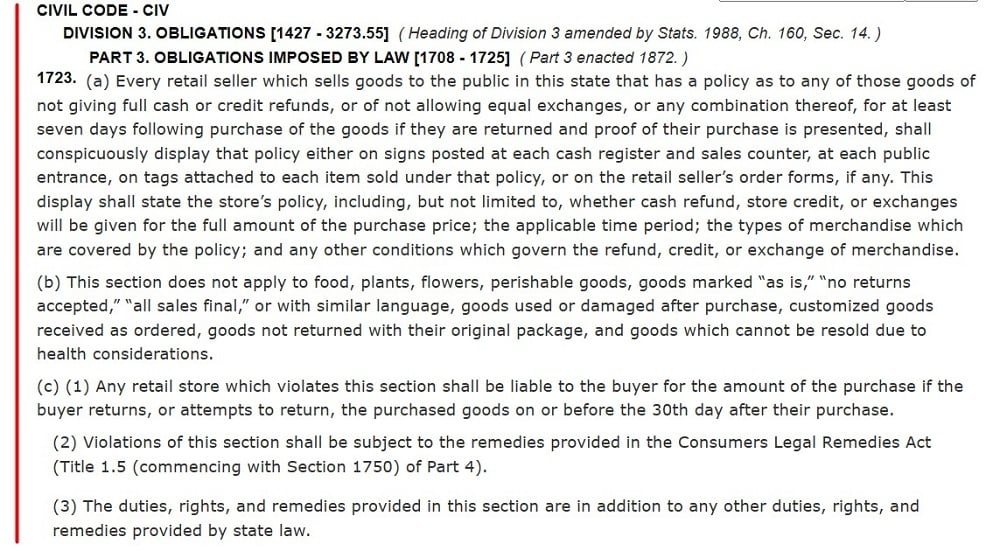
Many online stores that sell digital items have restrictions on returns or refunds. Whatever your personal policies are, you should explain your rules within your Return and Refund Policy and post the Policy somewhere consumers can easily find it.
What are Some International Return and Refund Laws?
Many countries around the world including Australia, the European Union (EU), and the United Kingdom (UK) all have laws regarding returns and refunds that apply to businesses operating within those locations.
For instance, the Consumer Rights Act 2015 is the UK's primary consumer protection law. It requires UK businesses to offer customers a repair, replacement, or refund if an item they purchase is defective or doesn't match its description.
Section 45 of Chapter 3 of the Consumer Rights Act 2015 explains that customers who purchase digital content have the right to receive a refund for the portion of their purchase that doesn't meet quality standards:
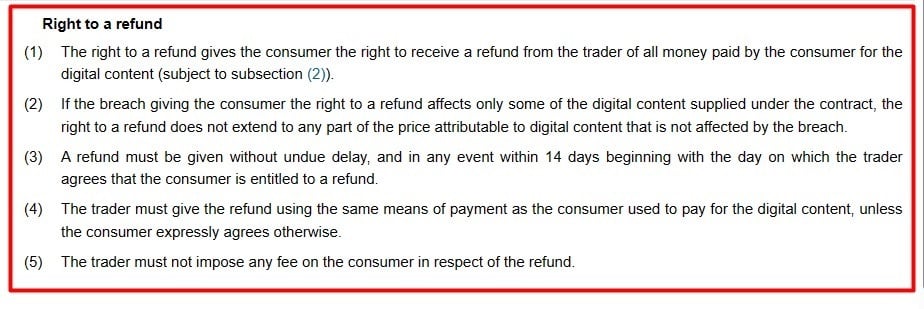
Similarly, the EU's Consumer Sales and Guarantees Directive gives consumers the right to request repairs or refunds for faulty digital products.
The European Commission's website explains the digital contract rules EU businesses must follow, including responding to consumer requests to fix defective digital content or services or providing a partial or full refund depending on the circumstances:
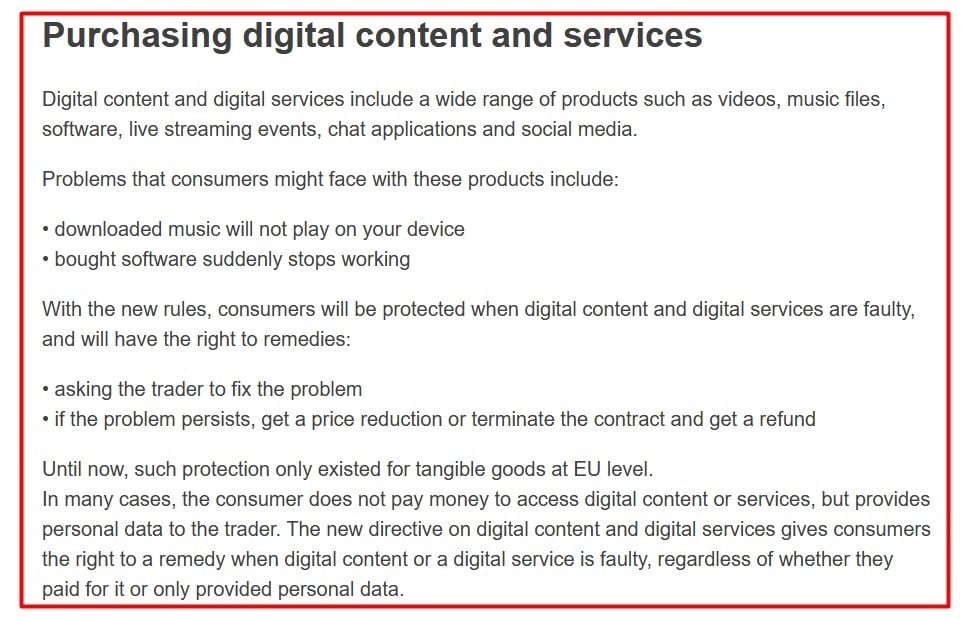
Sections 66, 67, and 68 of Directive (EU) 2019/770 describe some of the rules regarding digital products and explains that the law applies to digital products that are both sold to consumers and provided to them in exchange for their personal data:
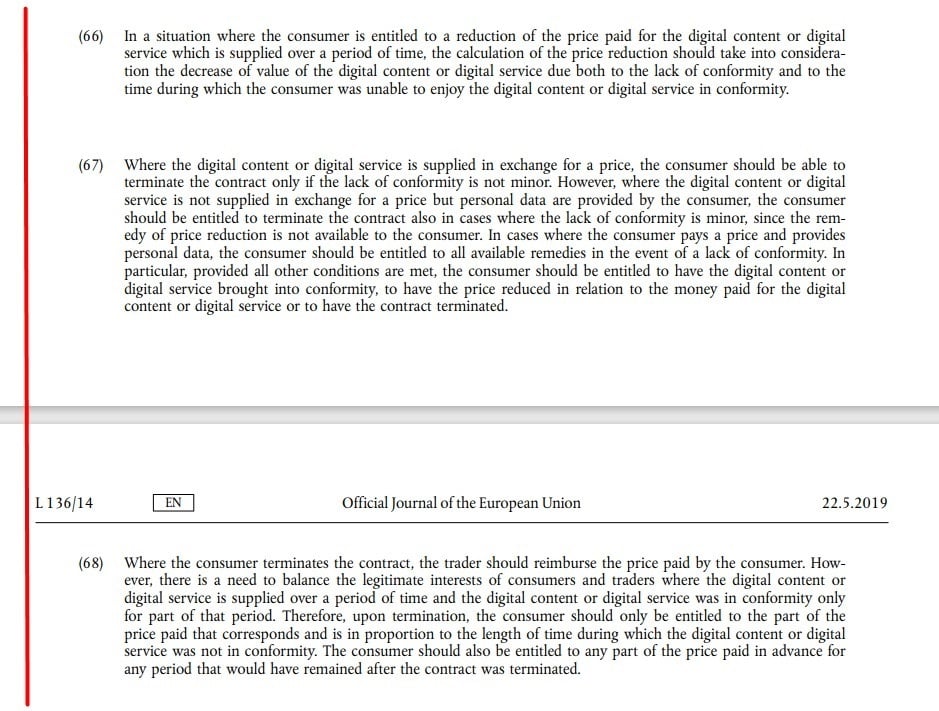
Now that you have an idea of some of the laws that may apply to you, you can start writing your Return and Refund Policy.
What Information Should Your Return and Refund Policy for Digital Products Include?
If you sell digital products, your Return and Refund Policy should include information about whether you allow returns or refunds and how consumers can initiate a return or request a refund for such products.
Let's take a look at some of the clauses you should include in your Return and Refund Policy for digital products.
Whether You Issue Refunds for Digital Products
Your Return and Refund Policy should explain whether you issue refunds for digital products. Many places do not, but some do, so you should be clear about this right away.
If you do offer refunds, this clause should detail the form customers can expect to receive their refund (credit card, check, etc.). It should also explain whether you offer partial or full refunds.
Google Play states that it does offer refunds for certain purchases, including accidental or unauthorized purchases. It explains that customers can request a refund from Google Play within 48 hours of buying an app or making an in-app purchase, and provides links and detailed policy information for refunds for other types of digital products:
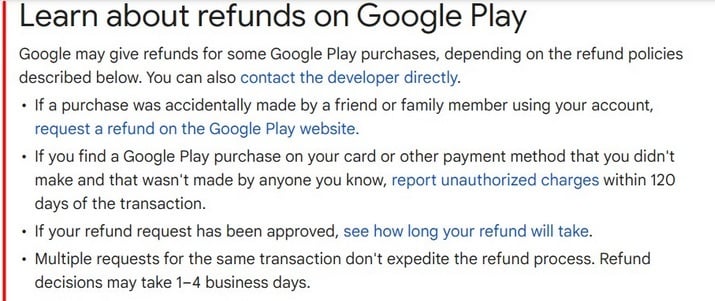
You may have an all sales final policy in place where no refunds are issued. Or, you may allow refunds on certain items but not on others.
Amazon's Return Policy includes a list of items that can't be returned, including digital products:
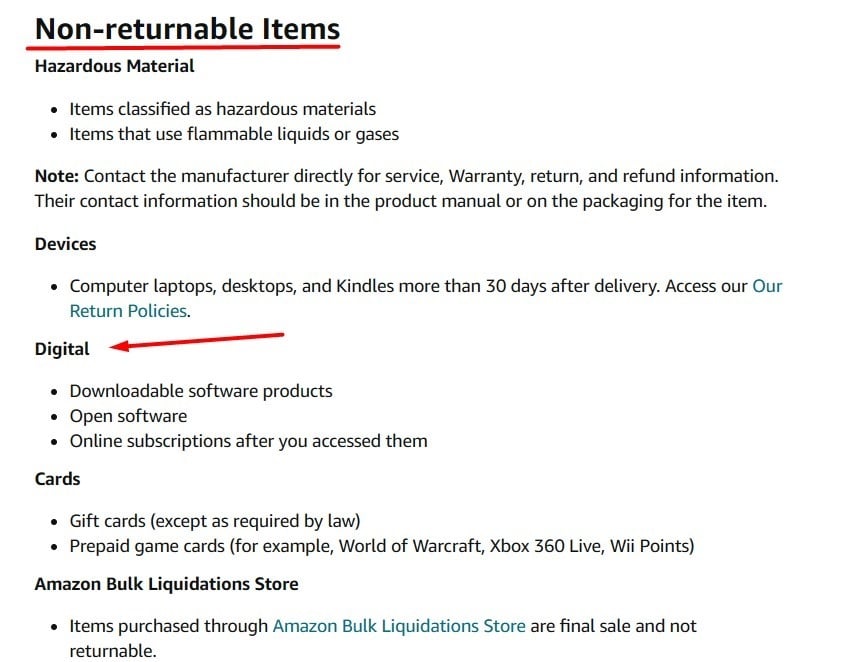
However, if a customer mistakenly buys a Kindle book, Amazon does allow customers to return the ebook within seven days of the purchase as long as the book hasn't been partially read:
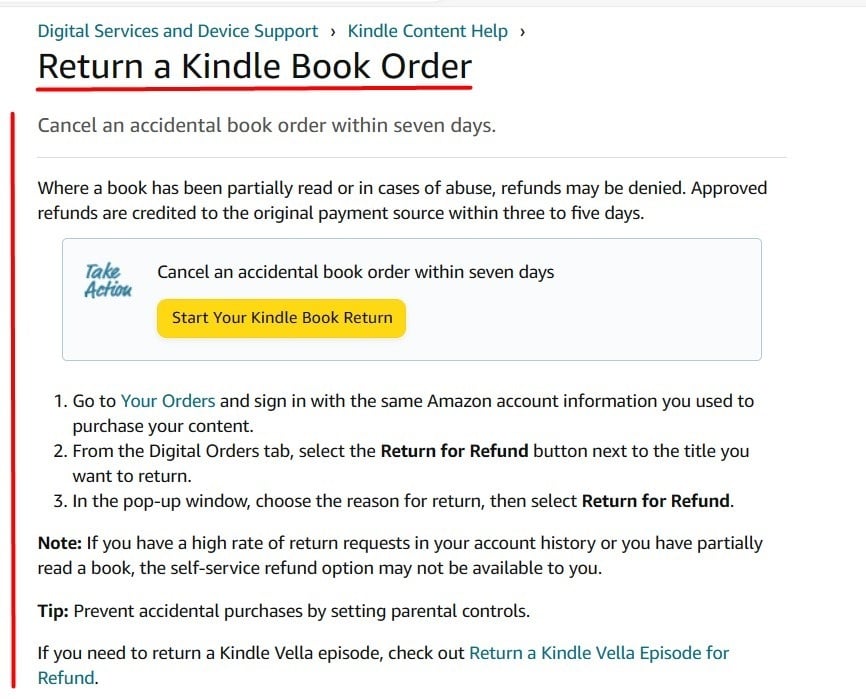
You can also outline specific situations when you will issue refunds, such as if the item has a problem or was advertised incorrectly. Here's an example of how this can look:
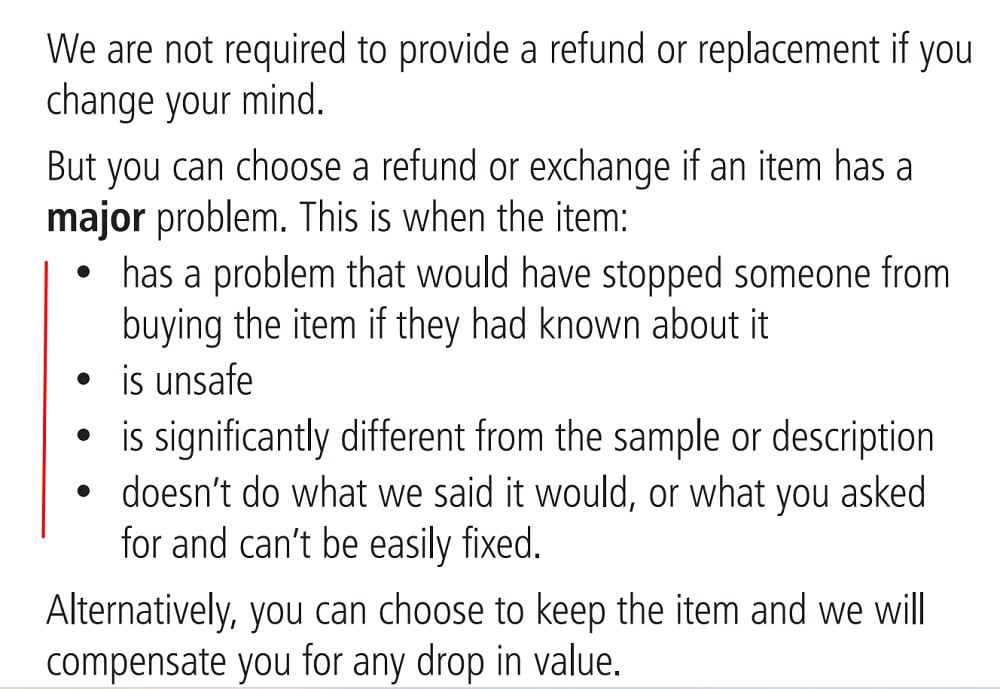
Requirements/Conditions for Returns
You should explain your requirements for returning a digital product. This can include timeframes for requesting a refund, or things like if you haven't used the digital product for very long (such as returning a digital movie when you've only watched 5 minutes of it versus finished it).
Here's an example of how this can look:
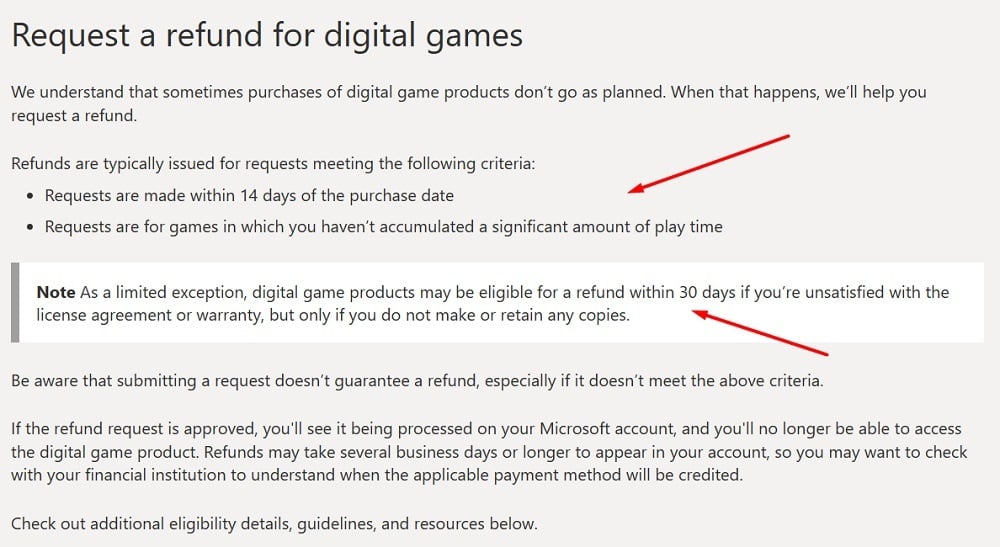
This clause explains how long the consumer has to return a digital product after purchasing it, as well as when they can expect to receive a new product if it is an exchange or a partial or full refund.
Intuit Quickbooks' Return Policy explains that customers who purchase electronically delivered products have 60 days from the date of purchase to request a refund via the link provided:
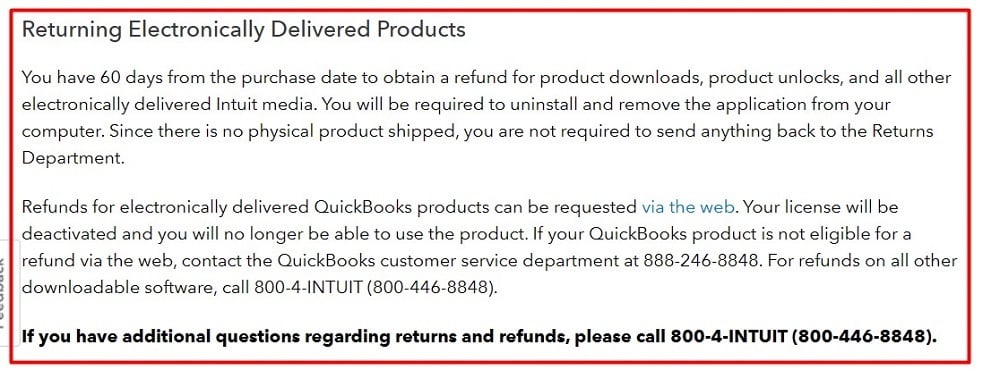
Refund Costs/Fees
Note whether there is any cost or fee associated with getting the refund, such as a percentage retained as a fee.
This may not be seen so often with digital products since they don't technically get physically restocked, but some businesses may choose to assess a fee anyway.
Here's how it can be noted in a Return and Refund Policy:
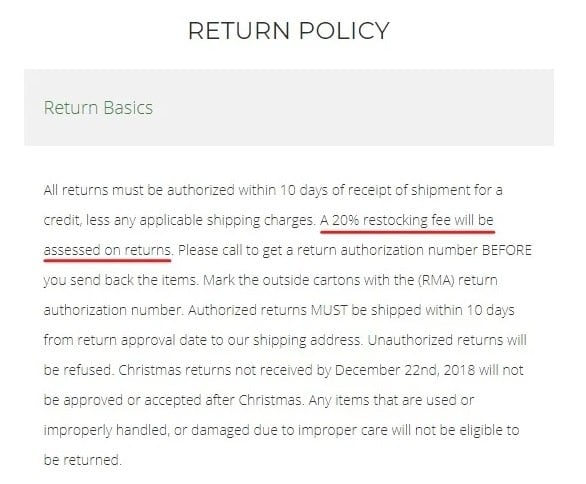
You can explain the fee to customers to help them understand your reasoning behind it, which will help with keeping customers from possibly getting annoyed at the fee. Here's an example:
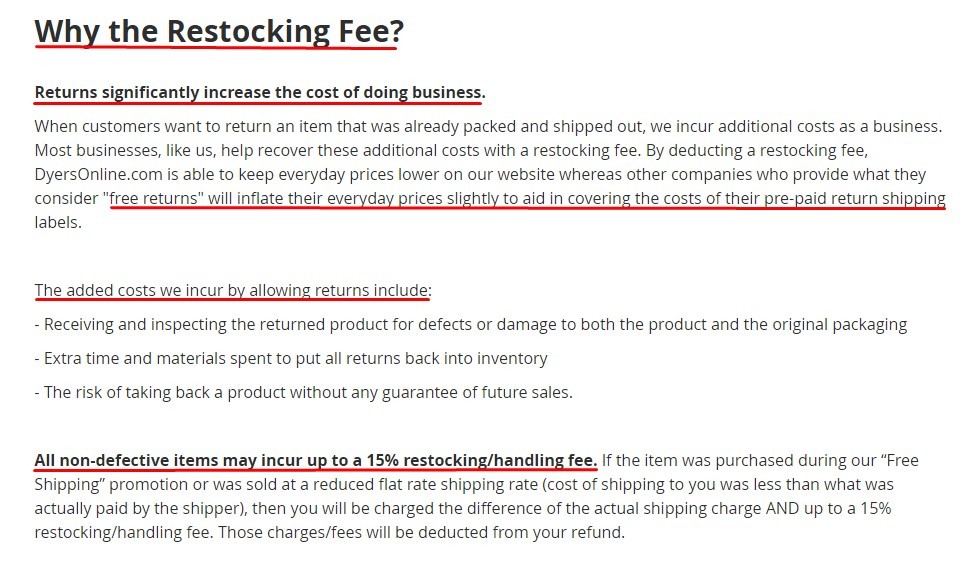
How to Initiate/Request a Refund
You should explain the steps customers need to take to request and receive a refund. This can be via contacting you, or through an online form or provided link.
Apple allows returns for some digital products, including apps and certain digital services. It explains how customers can request a refund and/or cancel a subscription:
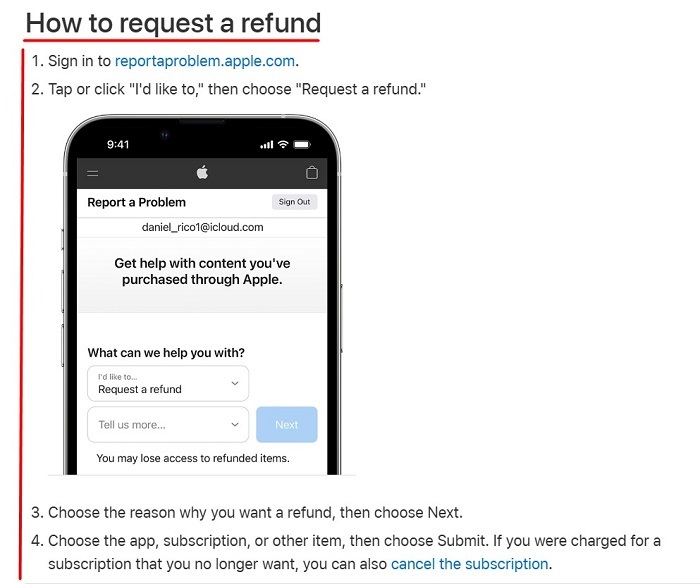
Expected Refund Timeline
Let people know how long they can expect to have to wait to get their refunds. This will be something they will want to know.
Be realistic and give a window of time versus a specific time to allow for delays.
Here's an example of how you can present this:
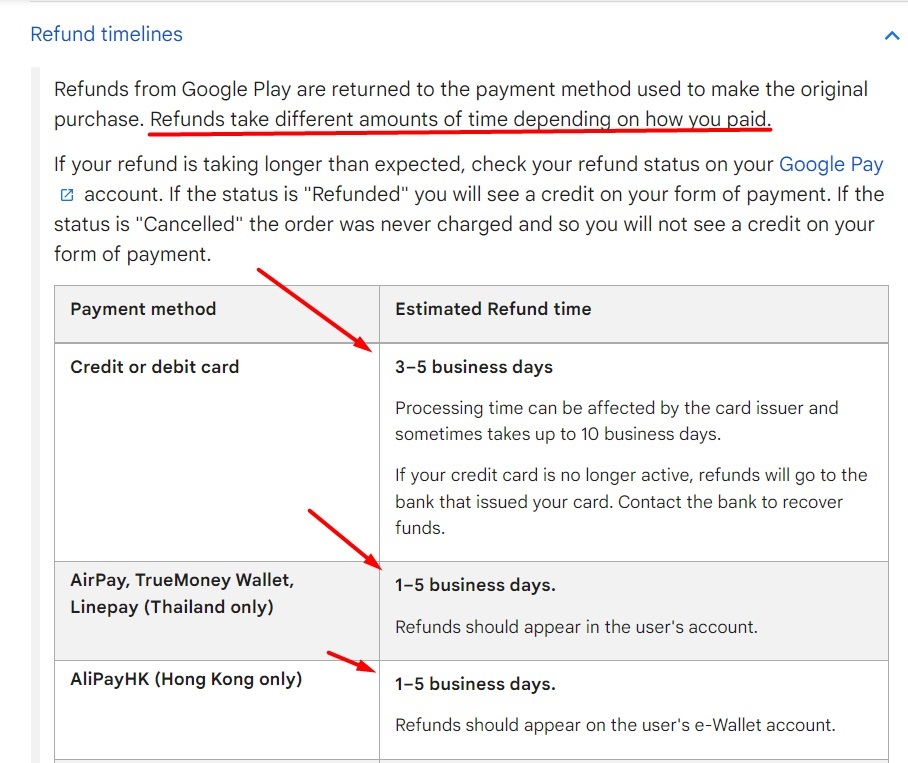
Udemy explains that customers can typically expect to receive a refund within 5-10 business days, and goes on to answer some commonly asked questions around the topic:
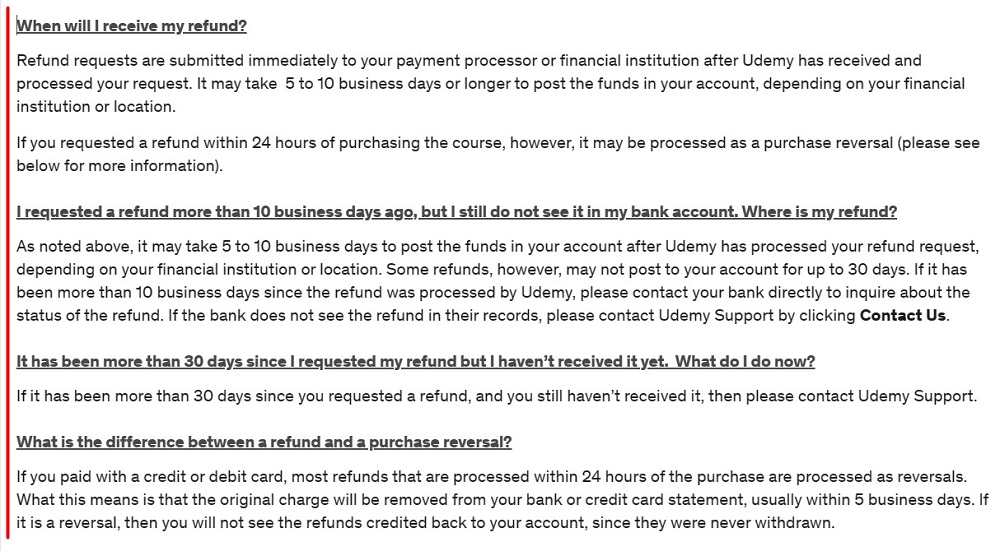
How Do You Display a Return and Refund Policy For Digital Products?
Put your policy somewhere where customers can easily find it. Common places to put a link to your Return and Refund Policy include in your website footer and on your checkout page.
You can also include your Return and Refund Policy within your Terms and Conditions agreement.
In a Website Footer
It is common practice for businesses to place their legal links in their website footer. Putting a link to your Return and Refund Policy within your website footer is a good way to ensure that customers can easily find it no matter what page of their site they're on.
The Laser Institute puts a link to its Cancellation/Return Policy in its website footer, along with informational and product links and its contact information:

In a Terms and Conditions Agreement
A Terms and Conditions agreement describes what consumers need to understand and agree to before using your digital products or services. Many businesses include their Return and Refund Policy within their Terms and Conditions agreements.
The best way to do this is to include a short clause that references your Return and Refund Policy and then link to your full policy.
Practical Defense Systems' Terms and Conditions agreement contains the rules that users must agree to in order to use its products and services, as well as its Return Policy and refund information. Ideally, the separate policy should be linked here as well:
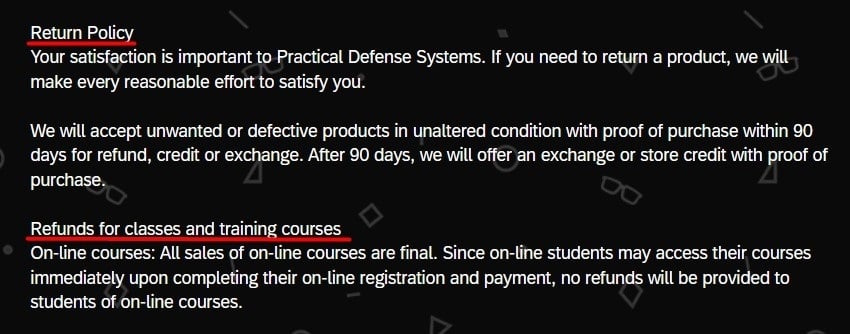
On a Checkout Page
This will be most commonly done by linking to the Terms agreement where the Refund Policy is noted.
You can also add the link to a statement that users have read and agree to your terms, and use an "I Agree" checkbox next to the statement to get consent.
Before purchasing an online course from Practical Defense Systems, customers must click a box stating that they agree to its Terms and Conditions agreement, which includes its Return Policy:

Summary
A Return and Refund Policy for digital products explains whether you accept returns of or provide refunds, and if so, how customers can request them. It describes what items are eligible for returns or refunds, and the timeline for returning a product or requesting a refund.
Having and conspicuously posting a Return and Refund Policy can help inform customers and encourage customer loyalty.
Maintaining a Return and Refund Policy can also help you to comply with applicable state and global consumer protection laws, including the California Civil Code, the UK's Consumer Rights Act 2015, and the EU's Consumer Sales and Guarantees Directive, among others.
To create an effective Return and Refund Policy for digital products, you will first need to understand what laws apply to you based on the location of your business. You should only include clauses that are relevant to your unique business, but a few common clauses for companies that sell digital products are:
- Whether you issue refunds
- Requirements/conditions for getting a refund
- Any fees or costs you charge
- How customers can initiate a refund request
- What the expected timeline is on receiving a refund
Once you have your Return and Refund Policy written, you will need to put it somewhere easily accessible such as in a website footer.

Comprehensive compliance starts with a Privacy Policy.
Comply with the law with our agreements, policies, and consent banners. Everything is included.
